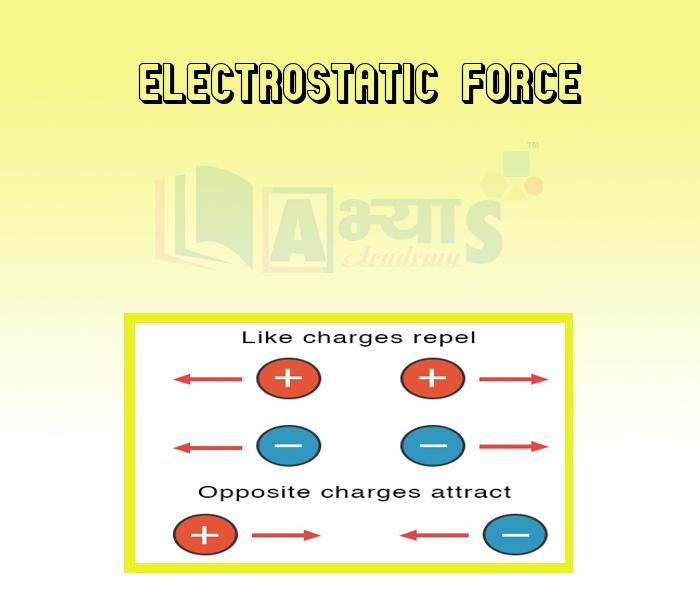Electrostatic Force







Electrostatic Force
Electrically charged objects exert force on an uncharged object or a charged object is called electrostatic force. For example, a plastic comb or plastic pen which is electrically charged by rubbing in dry hair, exerts an electrostatic force on uncharged tiny pieces of paper and attracts them.
The electric charges are of two types: positive electric charges and negative electric charges. Electric charges can be produced by friction when one object is rubbed over another object. The term 'electrostatic' refers to 'stationary electric charges'. An object having stationary electric charges (or static electric charges) on it is called electrically charged object. A comb acquires electrostatic charge after it has been rubbed with dry hair. An electrically charged object exerts an electrostatic force. It is called electrostatic force because the electric charges involved in it remain static (or stationary). The electric charges remain confined to the charged object and do not move.
Activity: To show that electrically charged by rubbing in dry hair, exerts an electrostatic force on uncharged tiny pieces of paper
1. Take a plastic comb (or plastic pen) and rub it in dry hair for about one minute.

2. Bring this comb near the tiny pieces of paper.

Observation: The comb attracts the tiny pieces of paper. The tiny pieces of paper move towards the comb and stick to it.
Explanation: When the plastic comb is rubbed in dry hair, the comb gets electric charges by friction. And when this electrically charged comb is brought near the tiny pieces of paper, it exerts an electrostatic force of attraction on them. Due to this electrostatic force, the tiny pieces of paper move towards the comb and stick to it.
Some more example of electrostatic force are
1 The electrostatic force is responsible for raising our body hair when we try to take off a terylene or polyester shirt in dry weather.

2. An inflated balloon when rubbed with a piece of synthetic cloth and then pressed against a wall, the balloon sticks to the wall. It is the electrostatic force which is responsible for the attraction between the balloon and the wall.

As the electrostatic force can be exerted by a charged object on another object from a distance, so it is an example of a non-contact force. Just like magnetic force, an electrostatic force can be of attraction or repulsion depending on the situation. The electrostatic force between any charged object (positively charged object or negatively charged object) and an uncharged object is always of attraction. The electrostatic force between two charged objects having like charges is that of repulsion. On the other hand, the electrostatic force between two charged objects having unlike charges is of attraction.
An inflated balloon when rubbed with a piece of synthetic cloth and then pressed against a wall. The balloon sticks to the wall. This is due to the ________________ | |||
| Right Option : A | |||
| View Explanation | |||
When an electrically charged object exert force on an uncharged object, then it is called as _______________ | |||
| Right Option : B | |||
| View Explanation | |||
The force an electrically charged objects exert on an uncharged object or a charged object is called _____________ . | |||
| Right Option : A | |||
| View Explanation | |||
Students / Parents Reviews [10]
About Abhyas metholodology the teachers are very nice and hardworking toward students.The Centre Head Mrs Anu Sethi is also a brilliant teacher.Abhyas has taught me how to overcome problems and has always taken my doubts and suppoeted me.

Shreya Shrivastava
8thMy experience with Abhyas academy is very good. I did not think that my every subject coming here will be so strong. The main thing is that the online tests had made me learn here more things.

Hiya Gupta
8thAbhyas is a complete education Institute. Here extreme care is taken by teacher with the help of regular exam. Extra classes also conducted by the institute, if the student is weak.

Om Umang
10thMy experience was very good with Abhyas academy. I am studying here from 6th class and I am satisfied by its results in my life. I improved a lot here ahead of school syllabus.

Ayan Ghosh
8thBeing a parent, I saw my daughter improvement in her studies by seeing a good result in all day to day compititive exam TMO, NSO, IEO etc and as well as studies. I have got a fruitful result from my daughter.

Prisha Gupta
8thIt was good as the experience because as we had come here we had been improved in a such envirnment created here.Extra is taught which is beneficial for future.

Eshan Arora
8thIt has a great methodology. Students here can get analysis to their test quickly.We can learn easily through PPTs and the testing methods are good. We know that where we have to practice

Barkha Arora
10thA marvelous experience with Abhyas. I am glad to share that my ward has achieved more than enough at the Ambala ABHYAS centre. Years have passed on and more and more he has gained. May the centre flourish and develop day by day by the grace of God.

Archit Segal
7thAbhyas Methodology is very good. It is based on according to student and each child manages accordingly to its properly. Methodology has improved the abilities of students to shine them in future.

Manish Kumar
10thMy experience with Abhyas is very good. I have learnt many things here like vedic maths and reasoning also. Teachers here first take our doubts and then there are assignments to verify our weak points.
